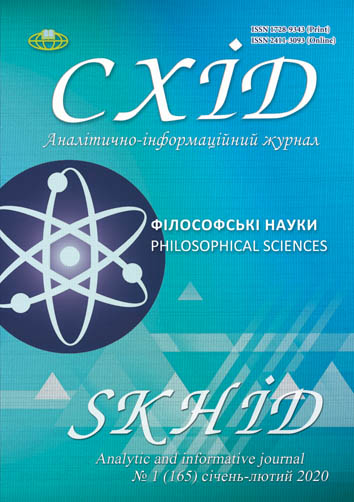Sociocultural challenges as determinants of the receptions and practices of modern yoga
DOI:
https://doi.org/10.21847/1728-9343.2020.1(165).196776Keywords:
reception and practice of yoga, modern yoga, the social in yoga, cultural and social determinants of yoga, body cultureAbstract
The dynamics of modern life in its cultural and social diversity indicates a special interest in modern yoga and its active implementation. The authors of the article try to identify those determinants that contribute to the development of yoga in modern conditions. They emphasize that interest in yoga is being formed under the influence of special factors characteristic of a post-industrial society with new sensations of time. The spread of new intellectual sensitivity also poses certain challenges for humans. Thus, this complex of sociocultural determinants activates interest in the cultural representations of the East. The desire to create personal and social reality sets up certain receptions and practices, and yoga is called upon to fulfill its special mission: it encourages us to study our basic outlooks on life, to become aware of which ones are fruitless nowadays, to search for more suitable ones nowadays in order to substitute the first ones.Downloads
References
Abera, T. (2017). Significance of yoga in modern life. International Journal of Yoga, Physiotherapy and Physical Education, 2 (5, Sept.): 123-125. Retrieved from https://www.researchgate.net/publication/320086473_Significance_of_yoga_in_modern_life (In English)
Asprey, D. (2017). Head Strong: The Bulletproof Plan to Activate Untapped Brain Energy to Work Smarter and Think Faster-in Just Two Weeks. Retrieved from http://loveread.ec/read_book.php?id=76940&p=1 (In Russian)
Baier, K. (2016). Modern Yoga Research: Insights and Questions. Retrieved from https://www.academia.edu/1239028/Modern_Yoga_Research (In English)
De Michelis, E. (2005). A History of Modern Yoga: Patanjali and Western Esotericism. Retrieved from http://modernyogaresearch.academia.edu/ElizabethDeMichelis (In English)
Deepak, K. S. (2016). Recent Development in Yoga: A Scientific Perspective Article. Journal Uttarakhand Ayurved University, Dehradun. Retrieved from https://www.researchgate.net/publication/301790362_-Recent_Development_in_Yoga_A_Scientific_Perspective (In English)
Deleuze, J. & Guattari, F. (1980). Kapitalizm i shizofreniya (Capitalism and schizophrenia). Book 2. A Thousand Plateaus. Retrieved from https://www.rulit.me/books/kapitalizm-i-shizofreniya-kniga-2-tysyacha-plato-read-250949-1.html (In Russian)
Deslippe, P. (2018). The Swami Circuit: Mapping the Terrain of Early American Yoga, Journal of Yoga Studies, 1: 5-44. DOI: https://doi.org/10.34000/joys.2018.v1.002 (In English)
Eliade, M. (2002a). History of Religious Ideas. Volume 1. From the Stone Age to the Eleusinian Mysteries. Moscow: Kriterion. (In Russian)
Eliade, M. (2002b). History of Religious Ideas. Volume 2. From Gautama Buddha to the Triumph of Christianity. Moscow: Kriterion. (In Russian)
Feuerstein, G. (2003). The Deeper Dimension of Yoga: Theory and Practice. Publisher: Shambhala Publications. Retrieved from https://-books.google.at/books/about/The_Deeper_Dimension_of_Yoga.html?id=QKWmOAnl8KwC&redir_esc=y (In English)
Feuerstein, G. (2006). Yoga for Dummies. Publisher: Wiley India Pvt. Limited. Retrieved from https://books.google.at/books?id¬=B9EXdJg96ekC-&dq=Georg+Feuerstein,+Yoga+For+Dummies&hl=en&sa=X&ved=0ahUKEwjMo7GD2LvkAhUPmIsKHSBlCK4Q6AEIKjAA (In English)
Gumbrecht, H. (2006). Proizvodstvo prisutstviya: Chego ne mozhet peredat znacheniye (Production of Presence: What Meaning Cannot Convey). Moscow: Novoye Literaturnoye Obozreniye (In Russian)
Muslim and Hindu Youth Unite at GIWA/KAIICID Summit (2018). Retrieved from http://washalliance.org/muslim-and-hindu-youth-unite-at-giwa-kaiicid-summit/ (In English)
Newcombe, S. (2009). The Development of Modern Yoga: A Survey of the Field. Religion Compass. 3(6): 986-1002. DOI: https://doi.org/10.1111/j.1749-8171.2009.00171.x (In English)
Newcombe, S. (2013). Magic and Yoga - The Role of Subcultures in Transcultural Exchange. Chapter from book Yoga Traveling: Bodily Practice in Transcultural Perspective: p. 57-79. DOI: https://doi.org/10.1007/978-3-319-00315-3_3 (In English)
Newcombe, S. (2019). How yoga conquered Britain: the feminist legacy of Yogini Sunita and Kailash Puri. Journal The Conversation. June 20. Retrieved from https://theconversation.com/how-yoga-conquered-britain-the-feminist-legacy-of-yogini-sunita-and-kailash-puri-118780 (In English)
Reddy, M. S., Starlin, Vijay M. (2016). Yoga in Psychiatry: An Examination of Concept, Efficacy, and Safety. Indian Journal Psychol. Med., Jul-Aug, 38(4): 275-278. DOI: https://doi.org/10.4103/0253-7176.185948 (In English)
Schnäbele, V. (2009). Yogapraxis und Gesellschaft. Eine Analyse der Transformations- und Subjektivierungsprozesse durch die Kör-perpraxis des modernen Yoga. Hamburg: Kovac, 240 s. (in German)
Sisk, J. (2007). Yoga and the Social Worker Mantra Meets Mental Health. Journal Social Work Today. 7(2): 30. Retrieved from https://www.socialworktoday.com/archive/marapr2007p30.shtml (In English)
Tibetan Yoga and Secret Doctrines (1957). From the Good Wishes of the All-Good Buddha Samanta-Bhadra, According to the Late Lama Kazi Dawa-Samdup's English Rendering. By W. Y. Evans-Wentz. Retrieved from http://bibleoteca.narod.ru/Tibet-doctrina.pdf (In Russian)
Woodyard, C. (2011). Exploring the therapeutic effects of yoga and its ability to increase quality of life. International Journal of Yoga. Jul-Dec, 4(2): 49-54. DOI: https://doi.org/10.4103/0973-6131.85485 (In English)
Downloads
Published
How to Cite
Issue
Section
License
Copyright (c) 2020 Viktoria Lobas

This work is licensed under a Creative Commons Attribution-NonCommercial-NoDerivatives 4.0 International License.
1. Authors bear responsibility for the accuracy of facts, quotations, numbers and names used.
2. Manuscripts are not sent back.
3. The publisher does not always agree with the authors' opinion.
4. The authors reserve the right to authorship of the work and pass the first publication right of this work to the journal under the terms of a Creative Commons Attribution-NonCommercial-NoDerivatives 4.0 International License. This license allows others to distribute (copy) the published work for non-commercial purposes, provided there is mandatory attribution to its authors and a link to the first publication in our journal.
5. The authors have the right to conclude separate supplement agreements that relate to non-exclusive work distribution in the form in which it has been published by the journal (for example, to upload the work to the online storage of the journal or publish it as part of a monograph), provided that the reference to the first publication of the work in this journal is included.

